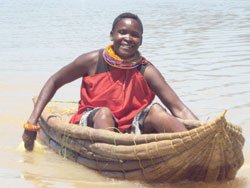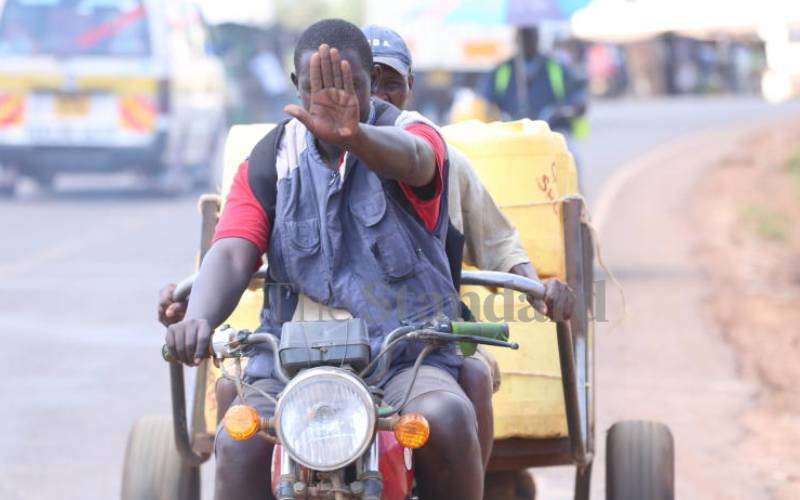JACQUELINE KANDAGOR attended the World Tourism Week in Lake Baringo and sampled the culture of the Njemps, a minority tribe living around the lake
It is the World Tourism Week and among the activities lined up in the itinerary of the six-day event is a boat riding competition on the bronze waters of Lake Baringo.
The dozens of participants climb onto the traditional ambath boats and soon the paddling under the blazing sun starts.  |
A Njemps woman rides a raft in Lake Baringo.[PHOTO:STANDARD] |
Some distance away, a group of children play in the water and as a resident narrates to us how hippos and crocodiles attack people, I shudder.
As the sun disappears behind the spectacular Tugen Hills on the western horizon, we emerge from under the shades of the mathenge trees, where we had been sheltering from the scorching sun for most of the afternoon.
A visitor to this small lakeside town, Kampi ya Samaki, might think the day starts at dusk on the shores of the lake, with activities mainly centred around fish.
Billows of smoke rise from various bedaubed fish smoking ovens scattered around the small shopping centre and the scent of smoked fish fills the air and hits our nostrils.
As we chat with the fishmongers, we realise they are not Tugens (the main ethnic group in Baringo), but mostly Turkanas, Luos and the Ilchamus (Njemps), an ethnic group related to the Maasai.
Caravan route
When John Thomson, the famous Scottish explorer, first sighted Lake Baringo in November 1883, the Ilchamus or Njemps community were already living on the shores of the lake.
These pastoralists are unique for they are the only group that rears cattle and practises fishing. Eating fish is a taboo among the Maasai, Samburu and even for the Tugen who live near the lake.
Only a few members of these communities took up fishing recently due to the harsh economic times.
The World Tourism Week was this year held in Baringo and its theme celebrated the culture of the Njemps, which is considered a minority tribe with a population of less than 40,000.
During World Tourism Day on September 27, held at the Njemps Cultural Centre, stakeholders from the tourism industry sampled the different cultures of the people living around the lake, mainly the host community, the Njemps.
The lake has 13 permanent islands, but during the dry season when the water levels of the lake go down, there are a dozen other rocky patches that appear on the lake.
The largest of these islands is Ol Kokwe, which means ‘meeting place’ in Njemps.
Bird watching
The western shores of the lake are bordered by fascinating basalt cliffs rising up to 100 metres, forming a bird watching paradise for tourists and bird watchers.
Baringo is home to the highest number of birds and one can see up to 300 species of birds.
Beyond these cliffs lie the spectacular Tugen Hills with Morop Hill rising up to meet the sky.
The local community wants it named as a mountain, considering its height of 7,000 feet, higher than Mount Longonot and the tallest mountain in Europe, Mount Blanc.
Before the arrival of motorboats, people used rafts and in the early afternoon, they wouldn’t attempt to row to the islands because the waves were very strong at this time. As we sail on the lake, we catch the glimpse of a hippo’s shiny furless coat.
The Njemps are linguistically related to the Maasai and the Samburu, and are possibly genetically related to one or both of these tribes.
The Njemps have many cultural associations to both groups and there are several theories as to their actual origin. One possibility is that the Njemps descended from a Samburu clan known as the Il-Doigo while another theory sees them as descendants of a Maasai clan driven out of the Laikipia area by inter-clan wars.
"We do not know who left the other. Maybe it is the Maasai who left us or maybe we are the ones who broke away," says mzee Riambale, gesturing at the eastern horizon in the direction of Samburu County.
Whatever their origins, this group moved into an area known as Njemps and adopted the name.
The other communities — the Pokot and Tugen — have derogatory names for the Njemps who they look down upon because of their consumption of fish that was taboo to them. Although they maintained many of the customs of the Maasai and Samburu nomads, the Njemps developed a different lifestyle.
The community abandoned the main characteristic of most pastoralists, nomadism, and settled down to grow crops on the shores of the lake.
Throughout the late 19th Century and even when the district headquarters was on the northern shores of the lake, they sold their produce to passing caravans of explorers and traders.
The fact that the caravan route to Uganda from the Coast passed through the region up to 1913 led to success of the business among the Njemps and enabled them refine their agricultural skills.
After the celebrations and activities such as mountain climbing, boat riding and discovering Baringo’s paradisiacal sites, we are tired and thirsty. It is such a relief to arrive at Lake Bogoria Spa and Resort, about 30km from Lake Baringo.
The drive through bushes and over hills and valleys ends at a compound with green and neatly mowed lawns near a stream with reed-lined banks.
As we alight from the vehicles, we are warmly met by hotel staff who hand us cool damp chamomile-scented face towels and a glass of freshly blended fruit juice.
It is the end of the cultural safari and as we have our lunch at the hotel’s Choma Ranch, reality dawns on us that we have to head back to our busy lives.
 The Standard Group Plc is a multi-media organization with investments in media
platforms spanning newspaper print operations, television, radio broadcasting,
digital and online services. The Standard Group is recognized as a leading
multi-media house in Kenya with a key influence in matters of national and
international interest.
The Standard Group Plc is a multi-media organization with investments in media
platforms spanning newspaper print operations, television, radio broadcasting,
digital and online services. The Standard Group is recognized as a leading
multi-media house in Kenya with a key influence in matters of national and
international interest.
 The Standard Group Plc is a multi-media organization with investments in media
platforms spanning newspaper print operations, television, radio broadcasting,
digital and online services. The Standard Group is recognized as a leading
multi-media house in Kenya with a key influence in matters of national and
international interest.
The Standard Group Plc is a multi-media organization with investments in media
platforms spanning newspaper print operations, television, radio broadcasting,
digital and online services. The Standard Group is recognized as a leading
multi-media house in Kenya with a key influence in matters of national and
international interest.










